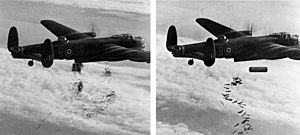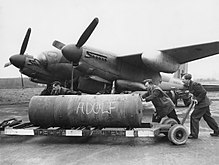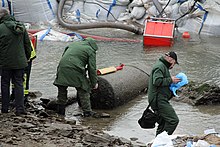| This article's lead section may be too short to adequately summarize the key points. Please consider expanding the lead to provide an accessible overview of all important aspects of the article. (November 2020) |

A blockbuster bomb or cookie was one of several of the largest conventional bombs used in World War II by the Royal Air Force (RAF). The term blockbuster was originally a name coined by the press and referred to a bomb which had enough explosive power to destroy an entire street or large building through the effects of blast in conjunction with incendiary bombs.
Design


The bombs, then called Blockbusters, were the RAF's HC (high capacity) bombs. These bombs had especially thin casings that allowed them to contain approximately three-quarters of their weight in explosive, with a 4,000 lb bomb (nominal weight) containing about 3,000 lb (1,400 kg) of explosive (Amatol, RDX or Torpex). Most general-purpose bombs, termed "medium capacity'" (MC) by the RAF, contained 50% explosive by weight, the rest being made up of the fragmentation casing. Larger Blockbusters were made later in the war, from the original 4,000 lb (1,800 kg) version, up to 12,000 lb (5,400 kg).
The 4000 lb High Capacity Mark I bomb – actual weight around 3,930 lb (1,780 kg) – was a welded, cylindrical shell of 0.31 in (7.9 mm) thick steel. The body of the bomb was 30 in (76 cm) in diameter and 88 in (2.24 m) long. The nose of the bomb was conical and a 27 in (69 cm) long lightweight, empty cylindrical tail with a closed end was fitted, for a total overall length of 115 in (2.92 m). A T-section steel beam was welded to the inner surface of the bomb to strengthen it. Subsequent Mark II and Mark III HC bombs differed in detail; the conical nose was replaced with a domed nose and the number of fuzes was increased from one to three to guarantee detonation. The Mark IV bomb did not have the T-section beam and the Mark V and Mark VI bombs were versions manufactured in the United States.
The larger 8,000 lb (3.6 t) bomb was constructed from two 4,000 lb (1.8 t) sections, of a larger 38 in (0.97 m) diameter, that fitted together with bolts. A 12,000 lb (5,400 kg) version was created by adding a third 4000 lb section and should not be confused with the 12,000lb Tallboy ground-penetrating "earthquake" bomb.
The 4000-lb high-capacity design was little more than a cylinder full of explosives: it was unaerodynamic and did not have fins. By comparison the similar American "4,000 pound LC Bomb AN-M56" bomb was aerodynamically designed as other US bombs were, with a sheet metal tailfin assembly and shaped nose and aft sections. When fitted with a conical "nose piece" and a drum tail, the 1,800 kg (2 short tons) British "Blockbuster" bomb fell straight down. These bombs were designed for their blast effect, to cause damage to buildings, specifically to blow roof tiles off, so that the small 4 lb (1.8 kg) incendiary bombs could reach the building interiors. In contrast to the American AN-M56 ordnance, the cylindrical "HC"-class British-design high capacity bombs were used only by the RAF and associated Commonwealth air forces, which were the only air forces with bombers with bomb bays large enough to hold them.
In 1947 Alfred Cecil Brooks of Stourbridge was appointed a Member of the Order of the British Empire, for creating the Blockbuster, although his citation was worded "outstanding services to the King of a nature that cannot be revealed". The local newspaper referred to him as "Blockbuster Brooks".
Operational use

The first type of aircraft to carry 4,000 lb (1.8 t) bombs operationally was the Wellington during a strike on Emden in April 1941; carriage of the bomb required the bomb beam to be removed from the bomb bay and a slot cut in the bomb doors - the bomb protruded slightly through this and, on release, simply fell out through the hole. The bomb later became part of the standard bomb load of the RAF's heavy night bombers, as well as that of the Mosquitoes of the Light Night Strike Force, whose aircraft would sometimes bomb Berlin twice in one night, flown by two different crews.
The 2,000-lb HC was used until the end of the war; use peaked in 1944 with over 16,000 dropped
The 8,000 lb (3.6 t) and the 12,000 lb (5.4 t) could be carried only by the Avro Lancaster which needed to be slightly modified with bulged bomb-bay doors.

The first use of the 8,000 lb (3.6 t) HC was by 15 Squadron Lancasters against Berlin on 2 December 1943. Bad weather and other factors meant their effectiveness was not noted.
The 4,000 lb (1.8 t) "cookie" was regarded as a particularly dangerous load to carry. Due to the airflow over the detonating pistols fitted in the nose, it would often explode even if dropped in a supposedly "safe" unarmed state. The safe height above ground for dropping the "cookie" was 6,000 ft (1,800 m); any lower and the dropping aircraft risked being damaged by the explosion's atmospheric shock wave:
We were flying at 6,000 feet which was the minimum height to drop the 4,000 pounder. We dropped it in the middle of town , which gave the aircraft a hell of a belt, lifted it up and blew an escape hatch from out of the top.
— Jack Murray, pilot of "G for George", reporting on G for George's mission on 17th April 1943.
617 Squadron developed a technique of dropping a 1,000lb MC bomb just before a 12,000lb HC bomb; the shock wave from the 1,000lb explosion fired the pistols on the 12,000lb bomb to give an "air burst"; this technique was used successfully in attacks including the Michelin factory at Clermont-Ferrand in March 1944.
Post-war unexploded ordnance

An unusual dry period led to low river levels in the Rhine in December 2011, exposing a 4,000-lb HC bomb in the riverbed near Koblenz. A radius of 2 kilometres (1.2 mi) around the bomb site (containing about 45,000 people) was evacuated while the bomb was defused. Another unexploded blockbuster was found in Dortmund in November 2013, requiring the evacuation of more than 20,000 people from the area. Other bombs were found and defused in Vicenza on 29 April 2001 and 25 April 2014. In 2001, defusing operations required the evacuation of 70,000 within a radius of 3 km (1.9 mi), while in 2014 defusing operations required the evacuation of 30,000 within a radius of 2.5 km (1.6 mi).
On 19 December 2016, a British bomb identified as a 4,000-lb HC "blockbuster" was discovered in Augsburg, Germany. It was defused on Christmas Day, requiring evacuation of more than 54,000 people within a radius of 1.5 km.
On 29 August 2017, another British HC 4000 bomb was discovered during construction work near the Goethe University in Frankfurt, requiring the evacuation of approximately 65,000 people within a radius of 1.5 km (0.93 mi). This was the largest evacuation in Germany since the Second World War.
On 8 April 2018, an HC 4000 bomb was discovered during gardening jobs in Paderborn, near the local university, leading to the evacuation of 26,400 people while the bomb was defused.
On 20 March 2024, a MK IV Bomb was found in a construction site in Viterbo, Italy causing an evacuation of more than 30,000 people in a range of 1400m from the discover site.
Bombs

2,000-lb HC
Design of a 2,000 lb to meet requirements of similar size to existing 1900-lb GP bomb was by Vickers with parachute arrangements by the RAF; this was at the same time Woolwich was designing the 4000lb bomb. Actual case construction was by Great Western Railway Company. Live tests began at start of 1941; a few were used operationally in late 1941 with parachute dropping and delay timer. The parachute requirement was dropped and from early 1942 they were used with conventional tail. Improved Mark II and Mark III (with different fuse positions) followed in 1943. Actual weight was 1,723 lb (782 kg) for Mark II and III with 71% charge to weight filling of 60/40 or 50/50 Amatol, RDX/TNT 60/40, or Torpex 2.
4,000-lb HC
- Mark I: first production design
- Mark II: three nose pistols
- Mark III: no side pistol pockets
- Mark IV: no stiffening beam
- Mark V: U.S. production
- Mark VI: U.S. production
Filling was Amatol, RDX/TNT, Minol, or Torpex. In 1943, 25,000 of these were used; this rose to 38,000 in 1944. In 1945 up to the end of the war a further 25,000 were used.
8,000-lb HC
- Mk I
- Mk II
Actual weight 7,860 lb (3,570 kg) with charge to weight ratio of 68%. Filling was 'Amatex 9' or 'Torpex 2'. Bombs were produced from 1942 to 1945.
12,000-lb HC
- Mk I
- Mk II
Charge weight ratio of 80%. Filling was Amatex or Torpex. 170 were produced in the last two years of the war.
Other uses
Air mines

During The Blitz the Germans used naval mines dropped with parachutes as improvised blockbusters. Their fuse was triggered by the shock of landing, with the bomb exploding after a 17-second delay. As the bomb was not in a crater, the force of the blast would disperse laterally, causing extensive damage. The large raid on Coventry on 14–15 November 1940 included the use of 50 parachute mines, which caused extensive blast damage. The British called these devices air-mines, a calque of the German term Luftmine. These types were used also during air raids on Malta, especially on its harbour areas.
See also
- 12,000 lb (5.4 t) Tallboy bomb
- 22,000 lb (10.0 t) Grand Slam bomb
- Firebombing
- Firestorm
- Pumpkin bomb, test Fat Man atom bomb casings filled with nearly six short tons (5.4 t) of Composition B explosive
- SC 1800 Satan, the rough German equivalent of the American AN-M56 general purpose "blockbuster".
- BLU-82
- MOAB
References
- Citations
- Ordnance Pamphlet 1665 (1946) pp.36–37
- Ordnance Pamphlet 1665 (1946) pp.39
- ^ Boyd, David. "8,000lb High Capacity Bomb". WWII Equipment. Archived from the original on 21 April 2012. Retrieved 4 December 2011.
- ^ Boyd, David. "12,000lb High Capacity Bomb". WWII Equipment. Archived from the original on 21 April 2012. Retrieved 4 December 2011.
- Air Publication AP1661B Vol I
- "Another Invention By Block-Buster Designer". The Advertiser. 8 January 1944. Archived from the original on 13 November 2016. Retrieved 12 November 2016.
- Polmar, N.; Allen, T.B. (2012). World War II: the Encyclopedia of the War Years, 1941-1945. Dover Books on Military History. Dover Publications. p. 166. ISBN 978-0-486-47962-0. Retrieved 13 March 2020.
- Murray, Iain (2012). Vickers Wellington Manual. Haynes. p. 100. ISBN 978-0-85733-230-1.
- ^ Boyd, David (1 January 2009). "2,000lb High Capacity Bomb". WWII Equipment. Retrieved 21 February 2021.
- Maynard, John Bennett and the Pathfinders 1956 Arms and Armour Press. p148
- "G-for-George" by Michael Nelmes and Ian Jenkins. Banner Books, Maryborough QLD, 2002. ISBN 1-875593-21-7
- Murray, Iain (2011). Dam Busters Manual. Haynes. p. 66. ISBN 978-0-85733-015-4.
- "Work to defuse WWII bomb in Rhine near Koblenz begins". BBC News. 4 December 2011. Archived from the original on 3 December 2011. Retrieved 4 December 2011.
- "4,000-pound, World War II bomb forces mass evacuation in Germany". CBS news. Associated Press. 3 November 2013. Archived from the original on 4 September 2017. Retrieved 3 September 2017.
- "Vicenza, settantamila evacuati per disinnescare la maxi bomba". La Repubblica (in Italian). Vicenza. 5 April 2001. Archived from the original on 15 May 2019. Retrieved 15 May 2019.
- "Vicenza si prepara al Bomba Day. Evacuazione per 30 mila". OggiTreviso (in Italian). Vicenza. 22 April 2014. Archived from the original on 26 April 2014. Retrieved 22 April 2014.
- "German city evacuated after discovery of unexploded RAF bomb". The Guardian. Associated Press. Archived from the original on 26 December 2016. Retrieved 26 December 2016.
- "Liveticker zur Fliegerbombe in Augsburg". Augsburger Allgemeine (in German). 21 December 2016. Archived from the original on 23 December 2016. Retrieved 3 September 2017.
- "WW2 'blockbuster' bomb to force evacuation of 70,000 in Frankfurt". The Guardian. Agence France-Presse. 31 August 2017. Archived from the original on 31 August 2017. Retrieved 31 August 2017.
- Hannelore Crolly (2 September 2017) . "Evakuierung in Frankfurt: Das macht die 'Blockbuster'-Bombe so gefährlich". Die Welt (in German). Archived from the original on 6 February 2019. Retrieved 1 September 2017.
- "Bombenalarm in Frankfurt: Ganz Frankfurt dankt den Helden des Tages". Frankfurter Allgemeine Zeitung (in German). 3 September 2017. Archived from the original on 4 September 2017. Retrieved 3 September 2017.
- "Wohnen auf dem Pulverfass". Westfalen-Blatt (in German). 3 April 2018. Archived from the original on 12 April 2018. Retrieved 12 April 2018.
- "Bombenentschärfung am 8. April 2018 in Paderborn" (in German). Retrieved 12 April 2018.
- "So verlief die Bombenentschärfung in Paderborn". Neue Westfälische (in German). 9 April 2018. Archived from the original on 11 April 2018. Retrieved 12 April 2018.
- Strocchia, Raffaele (3 May 2024). ""Cinque ore per neutralizzare la bomba". Ma la fine dell'evacuazione sarà annunciata solo con il suono delle sirene". ViterboToday (in Italian). Retrieved 3 September 2024.
- "The Luftwaffe over the Bristol area - Luftwaffe weapons". Archived from the original on 19 May 2006. Retrieved 20 May 2006.
- Montague Trout comment in a Collaborative Article: The Blitz by Mark E Archived 3 February 2009 at the Wayback Machine
- Taylor, Fredrick; Dresden Tuesday 13 February 1945, Pub Bloomsbury (first publication 2004, paperback 2005). ISBN 0-7475-7084-1. Page 120.
- Bibliography
- "English Bombs of WWII". Canadian Aces. Constable.ca. Archived from the original on 17 September 2012.
- British Explosive Ordnance (PDF) (Report). Ordnance Pamphlet. Department of the Navy, Ordnance Systems Command. 10 June 1946. Archived from the original (PDF) on 4 March 2016. Retrieved 2 February 2013.
External links
- A 12,000lb HC blockbuster pictured in the factory minus-tail unit
- A 12,000lb HC blockbuster being dropped
- An 8,000lb HC blockbuster about to be loaded aboard a Lancaster
| RAF strategic bombing during the Second World War | |
|---|---|
| Overviews | |
| Leaders | |
| Campaigns | |
| Operations | |
| Aircraft | |
| Technology | |
| Tactics | |
| Units | |
| See also | |
| British Commonwealth aircraft weapons of World War II | |
|---|---|
| Machine guns | |
| Cannon | |
| Rockets | |
| Heavy guns | |
| Bombs | |
Categories: